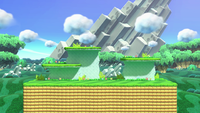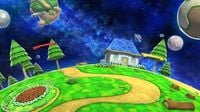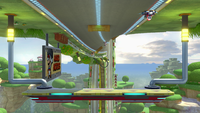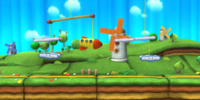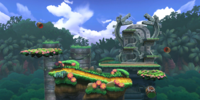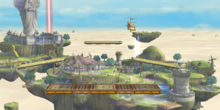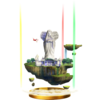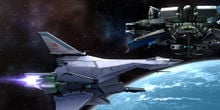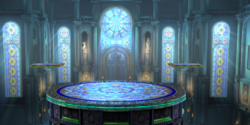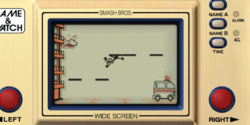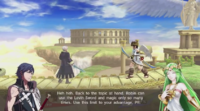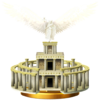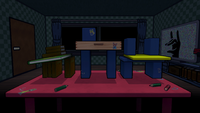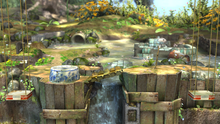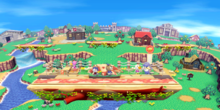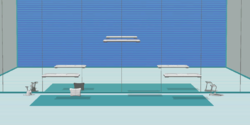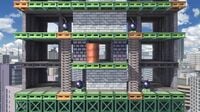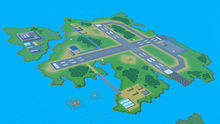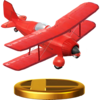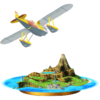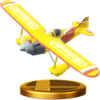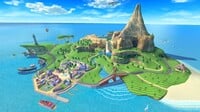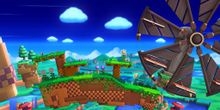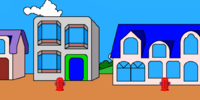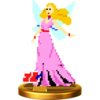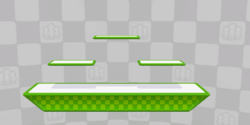List of stages debuting in Super Smash Bros. for Wii U
This is a list of Super Smash Bros. series stages that debuted in Super Smash Bros. for Wii U. The page details their role in this series.
See also:
- List of stages debuting in Super Smash Bros.
- List of stages debuting in Super Smash Bros. Melee
- List of stages debuting in Super Smash Bros. Brawl
- List of stages debuting in Super Smash Bros. for Nintendo 3DS and Super Smash Bros. for Wii U
- List of stages debuting in Super Smash Bros. Ultimate
Mushroom Kingdom U[edit]
- Main article: Mushroom Kingdom U
In Super Smash Bros. for Wii U and Super Smash Bros. Ultimate, Mushroom Kingdom U is available from the start.
Mario Galaxy[edit]
- Main article: Mario Galaxy (stage)
In Super Smash Bros. for Wii U and Super Smash Bros. Ultimate, Mario Galaxy is available from the start.
Mario Circuit[edit]
- Main article: Mario Circuit (Super Smash Bros. for Wii U)
In Super Smash Bros. for Wii U and Super Smash Bros. Ultimate, Mario Circuit is available from the start.
Woolly World[edit]
- Main article: Woolly World
Woolly World only appears in Super Smash Bros. for Wii U as a stage available from the start.
Jungle Hijinxs[edit]
- Main article: Jungle Hijinxs (stage)
Jungle Hijinxs only appears in Super Smash Bros. for Wii U as a stage available from the start.
Skyloft[edit]
Skyloft is a stage that appears in Super Smash Bros. for Wii U and Super Smash Bros. Ultimate, originating from The Legend of Zelda: Skyward Sword. It is a touring stage similar to Delfino Plaza from Super Smash Bros. Brawl.
Characters are transported around different parts of Skyloft via one main flat platform and three fall-through platforms. Locations where characters are dropped off include in front of the Statue of the Goddess, on top of the Light Tower, on the bridge crossing the river, in front of the Bazaar, on top of bird nests, and near the Skyloft residents' homes.
Songs in My Music[edit]
| Name | Source | Credits | Requirements |
|---|---|---|---|
| Ballad of the Goddess / Ghirahim's Theme | The Legend of Zelda: Skyward Sword | Arrangement Supervisor: Ryo Nagamatsu Composition: Nintendo Arrangement: Nintendo | |
| Main Theme / Underworld Theme | The Legend of Zelda | Arrangement Supervisor: Hideki Sakamoto Composition: Nintendo Arrangement: noisycroak Co.,Ltd. | |
| Gerudo Valley | The Legend of Zelda: Ocarina of Time | Arrangement Supervisor: Rio Hamamoto Composition: Nintendo Arrangement: BANDAI NAMCO Studios Inc. |
Clear 10-Man Smash within 17 seconds |
| Saria's Song / Middle Boss Battle | The Legend of Zelda: Ocarina of Time | Arrangement: Michiru Yamane Composition: Nintendo | |
| The Great Sea / Menu Select | The Legend of Zelda: The Wind Waker | Arrangement Supervisor: Tetsuya Shibata Composition: Nintendo Arrangement: Unique Note Co., Ltd. | |
| Tal Tal Heights | Super Smash Bros. Brawl (The Legend of Zelda: Link's Awakening) |
Arrangement Supervisor: Yusuke Takahama Composition: Nintendo Arrangement: TARGET ENTERTAINMENT INC. | |
| Village of the Blue Maiden | The Legend of Zelda: Four Swords Adventures | Original | |
| Ballad of the Goddess | The Legend of Zelda: Skyward Sword | Original | |
| Lorule Main Theme | The Legend of Zelda: A Link Between Worlds | Original |
Super Smash Bros. for Wii U trophy information[edit]
Gallery[edit]
Names in other languages[edit]
| Language | Name | Meaning | Notes |
|---|---|---|---|
| Japanese | スカイロフト[?] Sukairofuto |
Skyloft | |
| Chinese | 空中樓閣 (Traditional) 空中楼阁 (Simplified)[?] Kōngzhōnglóugé |
Skyloft Also the Chinese translation for the idiom "castle in the air." |
|
| Dutch | Skyloft[?] | - | |
| French | Célesbourg[?] | From céleste (celestial) and bourg (town) | |
| German | Wolkenhort[?] | Cloudhoard | |
| Italian | Oltrenuvola[?] | Beyond the cloud | |
| Korean | 스카이로프트[?] Seukairopeuteu |
Skyloft | |
| Portuguese | Arquipélago Celeste[?] | Celestial Archipelago | |
| Russian | Небоземь[?] Nebozem' |
Sky Land | |
| Spanish (Latin America) | Neburia[?] | From nebula (Latin for "cloud") and the place name suffix -ia | |
| Spanish (Europe) | Altárea[?] | Portmanteau of alto ("high") and área ("area") |
Pyrosphere[edit]
Pyrosphere is a stage that only appears in Super Smash Bros. for Wii U, representing the Metroid series. It is specifically based off the location appearing in Metroid: Other M. The stage holds up to eight players in both its regular and Omega forms.
Pyrosphere is set in the Geothermal Power Plant, and features a large base platform and two smaller platforms on both sides of the stage. Enemies from the game occasionally appear and attack players. These include FG II-Grahams, flying turrets which shoot at players; Joulions, which explode after being attacked; Zeros, which can be picked up and thrown; and, most notably, Ridley. Ridley will attack all players, but if attacked by a specific player enough, Ridley will join sides with that player, and will cease to hurt him or her. Ridley can also be KO'd, which adds a point to the player that defeated him.
Along with Jungle Hijinxs, Orbital Gate Assault, and Woolly World, Pyrosphere is one of the only stages from Super Smash Bros. for Wii U to not reappear in Super Smash Bros. Ultimate.
Songs in My Music[edit]
| Name | Source | Credits | Requirements |
|---|---|---|---|
| Vs. Ridley | Super Smash Bros. Brawl (Super Metroid) |
Arrangement Supervisor: Yusuke Takahama Composition: Nintendo Arrangement: TARGET ENTERTAINMENT INC. | |
| Title (Metroid) | Metroid | Arrangement: Kohta Takahashi Composition: Nintendo | |
| Escape | Metroid | Arrangement: Akari Kaida Composition: Nintendo | |
| Sector 1 | Super Smash Bros. Brawl (Metroid Fusion) |
Arrangement Supervisor: Minako Hamano Composition: Nintendo Arrangement: Nintendo | |
| Vs. Parasite Queen | Metroid Prime | Original | Recover stat boosts stolen by a Metroid in Smash Tour |
| Vs. Meta Ridley | Metroid Prime | Original | |
| Multiplayer (Metroid Prime 2: Echoes) | Metroid Prime 2: Echoes | Original | |
| Psycho Bits | Metroid Prime Hunters | Original | Collect CD |
| Nemesis Ridley | Metroid: Other M | Original | |
| Lockdown Battle Theme | Metroid: Other M | Original | Collect CD |
Names in other languages[edit]
| Language | Name | Meaning | Notes |
|---|---|---|---|
| Japanese | パイロスフィア[?] Pairosufia |
Pyrosphere | |
| Dutch | Pyrosphere[?] | - | |
| French | Pyrosphère[?] | Pyrosphere | |
| German | Pyrosphäre[?] | Pyrosphere | |
| Italian | Pirosfera[?] | Pyrosphere | |
| Portuguese | Pirosfera[?] | Pyrosphere | |
| Russian | Пиросфера[?] Pirosfera |
Pyrosphere | |
| Spanish | Pirosfera[?] | Pyrosphere |
The Great Cave Offensive[edit]
The Great Cave Offensive appears as a stage in Super Smash Bros. for Wii U and Super Smash Bros. Ultimate, based on the sub-game from Kirby Super Star and its remake. The stage is set inside a large cavern with every area of The Great Cave Offensive making an appearance, the Sub-Tree at the top, the Crystal area on the right, the Old Tower in the center running front top to bottom, and the Garden on the bottom left. Both this and the Omega version of the map are available in 8-Player Smash.
This is the largest stage in the game, being so big that to speed up the gameplay, "Danger Zones" (walls of lava) are on the wall set to automatically K.O. anyone above 100% damage. Treasure chests appear and disappear on the stage throughout the match, which spawn items when attacked. Minecarts appear on the stage that automatically move across the stage after some time, and players can ride upon them to hit other fighters.
The Omega version of the stage is set on a single circular platform, the left half based on the Sub-Tree area and the right being the Crystal area.
At the beginning of development, this stage was originally conceptualized as a stage based on Kirby's Epic Yarn. The stage was revamped into The Great Cave Offensive due to the announcement of Yoshi's Woolly World and the team deciding to create a stage based on that game.[1]
Songs[edit]
| Name | Source | Credits | Requirements |
|---|---|---|---|
| The Great Cave Offensive | Kirby Super Star | Arrangement Supervisor: Hideki Sakamoto Composition: HAL Laboratory, Inc. Arrangement: noisycroak Co., Ltd. | |
| Butter Building Ver. 2 | Kirby's Adventure | Arrangement Supervisor: Tsukasa Masuko Composition: HAL Laboratory, Inc. Arrangement: M's Factory Inc. | |
| King Dedede's Theme Ver. 2 | Kirby's Dream Land | Arrangement: Hideki Ishigaki, Hideki Onoue (HIDE+HIDE) Composition: HAL Laboratory, Inc. | |
| Forest/Nature Area | Kirby & The Amazing Mirror | Arrangement Supervisor: Yasunori Mitsuda Composition: HAL Laboratory, Inc. Arrangement: PROCYON STUDIO | |
| Green Greens Ver. 2 | Kirby's Dream Land | Arrangement: Masashi Hamauzu Composition: HAL Laboratory, Inc. | |
| Green Greens (Melee) | Super Smash Bros. Melee (Kirby's Dream Land) |
Arrangement Supervisor: Hirokazu Ando Composition: HAL Laboratory, Inc. Arrangement: HAL Laboratory, Inc. | |
| Squeak Squad Theme | Super Smash Bros. Brawl (Kirby: Squeak Squad) |
Arrangement: Hirokazu Tanaka Composition: HAL Laboratory, Inc. |
Collect CD |
| Celestial Valley | Kirby Air Ride | Original | |
| Frozen Hillside | Kirby Air Ride | Original | Collect CD |
| The Adventure Begins | Kirby's Return to Dream Land | Original | |
| Through the Forest | Kirby's Return to Dream Land | Original | |
| Floral Fields | Kirby: Triple Deluxe | Original |
Gallery[edit]
Names in other languages[edit]
| Language | Name | Meaning | Notes |
|---|---|---|---|
| Japanese | 洞窟大作戦[?] Dōkutsu Daisakusen |
Great Cave Campaign | |
| Chinese (Simplified) | 洞窟大作战[?] Dòngkū dà zuòzhàn |
Great Cave Battle | |
| Chinese (Traditional) | 洞窟大作戰[?] Dòngkū dà zuòzhàn |
Great Cave Battle | |
| Dutch | Het Grote Grotavontuur[?] | The Great Cave Adventure | |
| French | La Caverne du Péril[?] | The Cave of Peril | |
| German | Das Höhlen-Abenteuer[?] | The Cave Adventure | |
| Italian | La Grande Offensiva Speleologica[?] | The Great Speleological Offensive | |
| Korean | 동굴대작전[?] Donggul Daejakjeon |
Great Cave Campaign | |
| Portuguese | A Grande Caverna dos Tesouros[?] | The Great Cave of Treasures | |
| Russian | Пещерный переполох[?] Peshchernyy perepolokh |
Cave Stir | |
| Spanish | El gran ataque de las cavernas[?] | The great caves' attack |
Orbital Gate Assault[edit]
Orbital Gate Assault is a stage that only appears in Super Smash Bros. for Wii U. It originates from Star Fox: Assault.
The fight begins on the Great Fox. After some time the fighters are dropped onto an Aparoid missile; like the Great Fox the missile's jet boosters can damage fighters. During this time, an Aparoid fighter crashes onto the missile, damaging anybody hit by it and releasing an item, as well as Arwings appearing and flying away before the missile strikes the gate's force field. Touching the barrier surrounding the gate inflicts damage and knockback. Three Arwings destroy the missile and the battle shifts there. The fighters will be dropped off at the second missile as the Arwings barrel roll away. The second missile will hit the gate at the opposite direction but will be destroyed by the Arwings again, the battle once again being set on the Arwings before the fighters are dropped off on the Great Fox and the cycle starts over. ROB 64's line ("Missile approaching. It is targeting the gate.") is an archival recording of Dex Manley from Star Fox: Assault.
The omega version of the stage is set on a platform designed after the Orbital Gate itself. The platform travels around the Orbital Gate alongside three Arwings, though the battle no longer takes place.
One of two Star Fox conversations can be initiated on this stage by holding the shield button when selecting this stage with Fox and Falco both absent from the match.
The unlock match for Falco takes place here.
Along with Jungle Hijinxs, Pyrosphere, and Woolly World, Orbital Gate Assault is one of the only stages that appear in Super Smash Bros. for Wii U to not reappear in Super Smash Bros. Ultimate.
Songs in My Music[edit]
| Name | Source | Credits | Requirements |
|---|---|---|---|
| Theme from Area 6 / Missile Slipstream | Star Fox 64 / Star Fox Command | Arrangement Supervisor: Motoi Sakuraba | |
| Star Wolf's Theme / Sector Z | Star Fox 64 | Arrangement Supervisor: Mahito Yokota | |
| Corneria | Super Smash Bros. Melee (Star Fox) |
Arrangement Supervisor: Hirokazu Ando | |
| Main Theme (Star Fox 64) | Super Smash Bros. Brawl (Star Fox 64) |
Arrangement Supervisor: Yusuke Takahama | |
| Area 6 | Super Smash Bros. Brawl (Star Fox 64) |
Arrangement: Hajime Wakai | |
| Space Battleground | Star Fox: Assault | Original | |
| Break: Through the Ice | Star Fox: Assault | Original | |
| Star Wolf (Star Fox: Assault) | Star Fox: Assault | Original | Get a score of more than 20 in a single Rival Smash |
| Tunnel Theme (X-Scape) | X-Scape | Original | Collect CD |
Trophy information[edit]
Gallery[edit]
The Great Fox
Names in other languages[edit]
| Language | Name | Meaning | Notes |
|---|---|---|---|
| Japanese | オービタルゲート周域[?] Ōbitaru Gēto Shūiki |
Orbital Gate Area | |
| Dutch | Strijd om het Ruimtestation[?] | Battle in the Space Station | |
| French | Portail en orbite[?] | Portal in orbit | |
| German | Orbitales Tor[?] | Orbital Gate | |
| Italian | Stazione spaziale[?] | Space station | |
| Portuguese | Assalto ao Portal Orbital[?] | Assault on the Orbital Gate | |
| Russian | Орбитальный штурм[?] Orbital'nyy shturm |
Orbital assault | |
| Spanish | Estación espacial[?] | Space station |
Kalos Pokémon League[edit]
Kalos Pokémon League is a stage that appears in Super Smash Bros. for Wii U and Super Smash Bros. Ultimate. Hailing from Pokémon X and Pokémon Y, this stage is based on the Pokémon League in the Kalos region, where, as with other installments in the series, Trainers with eight badges may challenge the Elite Four and current Champion to become a Pokémon League Champion.
At first players start at the large platform where the lobby of Pokémon League is in the background. There is a large platform with two smaller platforms on each side; the two smaller platform move up as it is about to switch places. Just as in the original game, there are four chambers: the Ironworks Chamber, the Blazing Chamber, the Flood Chamber, and the Dragonmarks Chamber. Each chamber has its own respective number of Pokémon as well as stage hazards. The stage moves itself to the lobby and onto the other chamber.
In the Ironworks Chamber section, two large swords fall onto the stage, which damage players on contact. Steelix, Scizor, Klinklang, and Honedge appear in the background. Pools of liquid metal ooze out in the middle of the stage, turning characters who step on it into metal in an effect similar to Metal Boxes. Attacking swords embeds them to the deeper ground. Occasionally Registeel appears on the background. Once it appears, it stomps onto the ground, making the two swords spin around. Any character who is caught in the tremor is buried into the stage.
In the Blazing Chamber section, two platforms descend from the top. Along with the summoning of Blaziken, Infernape, Pyroar and Tepig, flame pillars burst out and lift the aforementioned platforms and can also damage players. Ho-Oh sometimes appears, raising the fire pillars up to the top of the screen and creating flames on each side of the pit.
The Flood Chamber is unique among them in that two waterways connect the stage, making it impossible to fall into the bottom while the waterways are connected. In this area, Wailord, Piplup, Clawitzer and Blastoise appears as background Pokémon. After a few seconds, streams of water pass through the left to right side or vice versa, pushing players to the left or right toward the blast line. As another stage hazard, Manaphy appears and creates a Whirlpool that sucks players in and down into the bottomless pit.
In the Dragonmarks Chamber, the stone sculpture of dragon opens by itself as four Pokémon, Garchomp, Dragonite, Axew and Hydreigon, appear in the background. Occasionally the dragon head roars, causing a purple flame burst out on the left or right side and on the middle. Rayquaza sometimes appears, acting as a stage hazard. It damages anyone who makes a contact with it, as it spins around similar to how it used Extreme Speed move in Super Smash Bros. Brawl. Its line of sight is indicated by a flash of lightning.
The stage's Omega form takes place on a large, cylinder-shaped platform in the main lobby area. The stage remains at the same place and does not move to the aforementioned four chambers.
Songs in My Music[edit]
| Name | Source | Credits | Requirements |
|---|---|---|---|
| Battle! (Trainer Battle) (Pokémon X / Pokémon Y) | Pokémon X / Pokémon Y | Arrangement Supervisor: Yuzo Koshiro Composition: GAME FREAK inc. Arrangement: Ancient-corp | |
| Battle! (Champion) / Champion Cynthia | Pokémon Diamond / Pokémon Pearl | Arrangement Supervisor: Manaka Katoka Composition: GAME FREAK inc. Arrangement: Nintendo | |
| Route 10 | Pokémon Black / Pokémon White | Arrangement Supervisor: Yoko Shimomura Composition: GAME FREAK inc. Arrangement: Midiplex Co., Ltd. | |
| N's Castle Medley | Pokémon Black / Pokémon White | Arrangement Supervisor: Shota Kageyama Composition: GAME FREAK inc. Arrangement: GAME FREAK inc. | |
| Battle! (Reshiram/Zekrom) | Pokémon Black / Pokémon White | Arrangement Supervisor: Atsuko Asahi Composition: GAME FREAK inc. Arrangement: Nintendo |
Clear at least 10 rounds in Crazy Orders while playing as Greninja. |
| Route 23 | Pokémon Black 2 / Pokémon White 2 | Arrangement: Yuka Tsujiyoko Composition: GAME FREAK inc. | |
| Battle! (Team Flare) | Pokémon X / Pokémon Y | Arrangement: Motoi Sakuraba Composition: GAME FREAK inc. | |
| Pokémon Center (Pokémon Red / Pokémon Blue) | Super Smash Bros. Brawl (Pokémon Red / Pokémon Blue) |
Arrangement Supervisor: Kentaro Ishizaka Composition: GAME FREAK Inc. Arrangement: HAL Laboratory, Inc. | |
| Battle! (Team Galactic) | Super Smash Bros. Brawl (Pokémon Diamond / Pokémon Pearl) |
Arrangement Supervisor: Masato Kouda Composition: GAME FREAK inc. | |
| Route 209 (Pokémon Diamond / Pokémon Pearl) | Super Smash Bros. Brawl (Pokémon Diamond / Pokémon Pearl) |
Arrangement Supervisor: Shogo Sakai Composition: GAME FREAK inc. Arrangement: HAL Laboratory, Inc. | |
| Battle! (Dialga/Palkia) / Spear Pillar | Super Smash Bros. Brawl (Pokémon Diamond / Pokémon Pearl) |
Arrangement Supervisor: Takahiro Nishi Composition: GAME FREAK inc. Arrangement: GAME ARTS Co.,Ltd. | |
| Battle! (Wild Pokémon) (Pokémon X / Pokémon Y) | Pokémon X / Pokémon Y | Original | Collect CD |
| Victory Road (Pokémon X / Pokémon Y) | Pokémon X / Pokémon Y | ||
| Battle! (Champion) (Pokémon X / Pokémon Y) | Pokémon X / Pokémon Y |
Names in other languages[edit]
| Language | Name | Meaning | Notes |
|---|---|---|---|
| Japanese | カロスポケモンリーグ[?] Karosu Pokemon Rīgu |
Kalos Pokémon League | |
| Chinese | 卡洛斯寶可夢聯盟 (Traditional) 卡洛斯宝可梦联盟 (Simplified)[?] Kǎluòsī Bǎokěmèng liánméng |
Kalos Pokémon League | |
| Dutch | Kalos League[?] | - | |
| French | Ligue Pokémon de Kalos[?] | Kalos Pokémon League | |
| German | Kalos-Pokémon-Liga[?] | Kalos Pokémon League | |
| Italian | Lega Pokémon di Kalos[?] | Kalos Pokémon League | |
| Korean | 칼로스 포켓몬리그[?] Kalloseu Poketmon Rigeu |
Kalos Pokémon League | |
| Portuguese | Liga Kalos[?] | Kalos League | |
| Russian | Лига Калос[?] Liga Kalos |
Kalos League | |
| Spanish | Liga Pokémon de Kalos[?] | Kalos Pokémon League |
Coliseum[edit]
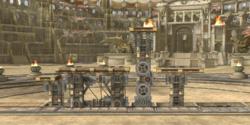
Coliseum is a stage appearing in Super Smash Bros. for Wii U. The stage is based not upon a specific game, but rather upon the recurring arenas in the Fire Emblem series. As in Arena Ferox in Super Smash Bros. for Nintendo 3DS the stage is set inside the arena itself, though by default, it is a flat, grounded stage. During the match, parts of the floor rise to create platforms of varying heights.
The Omega variant of this stage is set on an elevated platform over a pit.
The unlock match for Lucina takes place here.
Coliseum reappears as a stage in Super Smash Bros. Ultimate.
Songs[edit]
| Name | Source | Credits | Requirements |
|---|---|---|---|
| The Devoted | Fire Emblem: Radiant Dawn | Original | |
| Coliseum Series Medley | Fire Emblem (Series) | Arrangement: Akari Kaida Composition: INTELLIGENT SYSTEMS | |
| Fight 1 (Fire Emblem Gaiden) | Fire Emblem Gaiden | Arrangement: Michiru Yamane Composition: INTELLIGENT SYSTEMS | |
| Meeting Theme Series Medley | Fire Emblem (Series) | Arrangement: Yuka Tsujiyoko Composition: INTELLIGENT SYSTEMS | |
| Fire Emblem: Mystery of the Emblem Medley | Fire Emblem (Series) | Arrangement Supervisor: Jesahm Composition: INTELLIGENT SYSTEMS Arrangement: BANDAI NAMCO Studios Inc. | |
| Time of Action | Fire Emblem: Radiant Dawn | Original | |
| Id (Purpose) | Fire Emblem Awakening | Original | |
| Duty (Ablaze) | Fire Emblem Awakening | Original | |
| Conquest (Ablaze) | Fire Emblem Awakening | Original | Get four or more Fever Rushes in one game of solo Trophy Rush as Robin. |
| Glory of Heracles | Glory of Heracles | Arrangement: Hideki Ishigaki, Hideki Onoue (HIDE+HIDE) Composition: PAON CORPORATION |
Collect CD |
| Attack (Soma Bringer) | Soma Bringer | Original | |
| Lost in Thoughts All Alone | Fire Emblem Fates | Arrangement Supervisor: Junichi Nakatsuru Composition: INTELLIGENT SYSTEMS Arrangement: BANDAI NAMCO Studios Inc. |
Included with Corrin DLC |
| Lost in Thoughts All Alone | Fire Emblem Fates | Original | Included with Corrin DLC |
Names in other languages[edit]
| Language | Name | Meaning | Notes |
|---|---|---|---|
| Japanese | 闘技場[?] Tōgijō |
Arena | |
| Chinese | 鬥技場 (Traditional) 斗技场 (Simplified)[?] Dòu jì chǎng |
Arena | |
| Dutch | Arena[?] | - | |
| French | Arène[?] | Arena | |
| German | Kolosseum[?] | Coliseum | |
| Italian | Arena[?] | Arena | |
| Korean | 투기장[?] Tugijang |
Arena | |
| Portuguese | Coliseu[?] | Coliseum | |
| Russian | Колизей[?] Kolizey |
Coliseum | |
| Spanish | Coliseo[?] | Coliseum |
Flat Zone X[edit]
Flat Zone X is an unlockable stage appearing in Super Smash Bros. for Wii U, unlocked by breaking at least 100 blocks in a single game of solo Trophy Rush while playing as Mr. Game & Watch. Based upon and set inside a Game & Watch handheld, the stage combines the various games featured in the Flat Zone and Flat Zone 2 stages in Super Smash Bros. Melee and Super Smash Bros. Brawl, respectively.
Like Flat Zone 2 in Super Smash Bros. for Nintendo 3DS, the Omega form of this stage is set on top of the gas station from the Oil Panic portion of the stage.
The unlock match for Mr. Game & Watch takes place here.
Flat Zone X reappears in Super Smash Bros. Ultimate. Due to the Dr. Mario music listed below now playing on Super Mario stages, the stage now has the fewest amount of My Music tracks with only two, being tied with Midgar, unless the player has purchased Challenger Pack 8.
Songs in My Music[edit]
| Name | Source | Credits |
|---|---|---|
| Flat Zone 2 | Super Smash Bros. Brawl (Game & Watch) |
Original Composition: Kenichi Okuma |
| Flat Zone | Super Smash Bros. Melee (Game & Watch) |
Original Composition Supervisor: Hirokazu Ando |
| Chill (Dr. Mario) | Super Smash Bros. Brawl (Dr. Mario) |
Arrangement: Masaaki Iwasaki Composition: Nintendo |
| Dr. Mario | Super Smash Bros. Melee (Dr. Mario) |
Arrangement Supervisor: Shogo Sakai Composition: Nintendo Arrangement: HAL Laboratory, Inc. |
Events[edit]
- That Elusive 9 (Solo)
Names in other languages[edit]
| Language | Name | Meaning | Notes |
|---|---|---|---|
| Japanese | フラットゾーンX[?] Furatto Zōn Ekkusu |
Flat Zone X | |
| Chinese | 平面世界X[?] Píngmiàn shìjiè X |
Plane World X | |
| Dutch | 2D-Zone X[?] | - | |
| French | Espace 2D X[?] | 2D Space X | |
| German | 2D-Welt X[?] | 2D World X | |
| Italian | La zona bidimensionale X[?] | The two-dimensional zone X | |
| Korean | 플랫 존X[?] Peullaet Jon X |
Flat Zone X | |
| Portuguese | Zona Plana X[?] | Flat Zone X | |
| Russian | Плоская зона X[?] Ploskaya zona X |
Flat Zone X | |
| Spanish | Zona extraplana X[?] | Extra-Flat Zone X |
Palutena's Temple[edit]
Palutena's Temple is a stage appearing in Super Smash Bros. for Wii U and Super Smash Bros. Ultimate, based upon the location as it appears in Kid Icarus: Uprising. The stage is a larger stage in the same vein as Temple from Super Smash Bros. Melee and New Pork City in Super Smash Bros. Brawl. The left side of the stage is set on and inside the temple itself, while the right side is set on a floating island nearby, with a temple and statue of Palutena in the background. There is a bridge connecting the two sides of the stage near the top that can be broken, though there are also moving platforms and clouds that can be used to reach either side. On the top left side of the stage is a smaller temple area that flies up offscreen and back down periodically, and on the left side is a large platform that raises and lowers, with a ladder next to it.
The Omega form of the stage is set on the large moving platform in front of the Palutena statue.
The unlock match for Dark Pit takes place here.
Palutena's Guidance[edit]
- Main section: Smash Taunt § Palutena's Guidance
By using Pit's down taunt for one frame on this stage, he begins a Smash Taunt, entering a praying stance rather than his normal taunt. This triggers a conversation between Pit, Palutena, and Viridi about one of the opposing fighters, referred to as Palutena's Guidance. The concept is similar to Snake's codec conversations in Super Smash Bros. Brawl and is based on the conversations that periodically occur throughout gameplay between the characters in Kid Icarus: Uprising. If Pit is KO'd at any point during the conversation, it automatically ends, and it does not trigger at all if Pit is attacked while he is in the stance to trigger the taunt. This taunt can only be used once per match, and is disabled in its Ω form (as well as its Battlefield form in Super Smash Bros. Ultimate). Palutena's Guidance uses a generic conversation for DLC fighters, in which Palutena says she has no data on them.
Palutena's Guidance returns in Super Smash Bros. Ultimate, where new conversations were made for characters who were absent from the base roster of Super Smash Bros. for Wii U. While the first DLC character of Super Smash Bros. Ultimate, Piranha Plant, received its own Palutena's Guidance, none of the fighters that are part the Fighters Pass for the game have their own conversations, instead using the same generic conversation as Super Smash Bros for Wii U's DLC characters.
Songs in My Music[edit]
| Name | Source | Credits | Requirements |
|---|---|---|---|
| Boss Fight 1 (Kid Icarus: Uprising) | Kid Icarus: Uprising | Original | |
| In the Space-Pirate Ship | Composition Supervisor: Noriyuki Iwadare Arrangement: Noriyuki Iwadare Composition: TWO FIVE |
Score 80,000 points or more on Stage 2 in Solo Target Blast while playing as Palutena. | |
| Wrath of the Reset Bomb | Arrangement Supervisor: Yuzo Koshiro Composition: Ancient-corp. Arrangement: Ancient-corp. | ||
| Lightning Chariot Base | Arrangement Supervisor: Masafumi Takada Composition: Sound Prestige LLC. Arrangement: Sound Prestige LLC. | ||
| Destroyed Skyworld | Arrangement: Manami Kiyota | ||
| Magnus's Theme | Original | ||
| Dark Pit's Theme | Original | ||
| Hades's Infernal Theme | Original | ||
| Thunder Cloud Temple | Original | ||
| Weyard | Golden Sun: Dark Dawn | Original | Collect CD |
Super Smash Bros. for Wii U trophy information[edit]
Names in other languages[edit]
| Language | Name | Meaning | Notes |
|---|---|---|---|
| Japanese | エンジェランド[?] Enje Rando |
Angel Land | |
| Dutch | Palutena's Tempel[?] | Palutena's Temple | |
| French | Temple de Palutena[?] | Palutena's Temple | |
| German | Palutenas Tempel[?] | Palutena's Temple | |
| Italian | Tempio di Palutena[?] | Palutena's Temple | |
| Korean | 엔젤랜드[?] Enjellandeu |
Angel Land | |
| Portuguese | Templo da Palutena[?] | Palutena's Temple | |
| Russian | Храм Палютены[?] Khram Palyuteny |
Palutena's Temple | |
| Spanish | Templo de Palutena[?] | Palutena's Temple |
Gamer[edit]
- Main article: Gamer (stage)
In Super Smash Bros. for Wii U and Super Smash Bros. Ultimate, Gamer is available from the start.
Garden of Hope[edit]
Garden of Hope is a stage that appears in Super Smash Bros. for Wii U and Super Smash Bros. Ultimate, originating from Pikmin 3 for the Wii U. The stage is made up of two platforms connected by a bridge, with two tin lifts on either side of the stage itself. On the left platform is an upside-down porcelain pot, which can break apart when damaged several times, while on the right is a climbing stick, which serves as an obstruction and is also destructible. Like in Gerudo Valley in Super Smash Bros. for Nintendo 3DS, the connecting bridge can be broken as well. If any of the objects are broken, Pikmin will appear from the background after a while to repair them.
Occasionally, a Peckish Aristocrab may appear and sidestep across the stage, breaking the pot and stick (if not already broken) and damaging any players it touches. If the bridge is broken, however, it will fall down the pit. A Red Bulborb occasionally appears in the background, although it has no effect on the gameplay.
Songs in My Music[edit]
| Name | Source | Credits | Requirements |
|---|---|---|---|
| Stage Select (Pikmin 2) | Pikmin 2 | Arrangement Supervisor: Masashi Hamauzu | |
| Mission Mode (Pikmin 3) | Pikmin 3 | Arrangement Supervisor: Taku Inoue | Clear Solo Classic within 20 minutes as Olimar |
| Stage Clear / Title (Pikmin) | Super Smash Bros. Brawl (Pikmin) |
Arrangement Supervisor: Kentaro Ishizaka | |
| Environmental Noises | Super Smash Bros. Brawl (Pikmin) |
Arrangement Supervisor: Takahiro Nishi | |
| World Map (Pikmin 2) | Super Smash Bros. Brawl (Pikmin 2) |
Arrangement Supervisor: Yasunori Mitsuda | |
| Main Theme (Pikmin) | Pikmin | Original | |
| Forest of Hope | Pikmin | Original | Collect CD |
| Garden of Hope | Pikmin 3 | Original |
Names in other languages[edit]
| Language | Name | Meaning | Notes |
|---|---|---|---|
| Japanese | 再会の花園[?] Saikai no Hanazono |
Garden of Reunion | |
| Chinese | 再會花園 (Traditional) 再会花园 (Simplified)[?] Zài huì huāyuán |
Lit. "Reunion Garden" 「再會」 (zài huì) is another way of saying "goodbye" or "see you again." |
|
| Dutch | Pikmin-Paradijs[?] | Pikmin Paradise | |
| French | Verger de l'espoir[?] | Orchard of Hope | |
| German | Garten der Begegnung[?] | Garden of Encounter | |
| Italian | Serra speranza[?] | Hope greenhouse | |
| Korean | 재회의 화원[?] Jaehoe-ui Hwawon |
Garden of Reunion | |
| Portuguese | Jardim da Esperança[?] | Garden of Hope | |
| Russian | Сад Надежды[?] Sad Nadezhdy |
Garden of Hope | |
| Spanish | Vergel de la Esperanza[?] | Garden of Hope |
Town and City[edit]
Town and City, originally named Town & City,[2] is a stage that appears in Super Smash Bros. for Wii U and Super Smash Bros. Ultimate, originating from Animal Crossing: City Folk for the Wii. The stage is similar to Smashville from Super Smash Bros. Brawl, being a simple stage that has various characters from the Animal Crossing series appear in the background. The stage travels over the village, moving into the City from Animal Crossing: City Folk. Much like Smashville from Super Smash Bros. Brawl, the stage has been shown to take place at different times, including day, evening, and night depending on the current time set on the console's internal clock; the elements that appear on the stage such as the places and animals are also influenced by the time of day at which the stage is played. In Ultimate, the stage was renamed "Town and City" as its current name.
Songs in My Music[edit]
| Name | Source | Credits |
|---|---|---|
| Plaza / Title (Animal Crossing: City Folk / Animal Crossing: Wild World) | Animal Crossing: City Folk / Animal Crossing: Wild World | Arrangement: Kumi Tanioka |
| Tour | Animal Crossing: New Leaf | Arrangement Supervisor: Hajime Wakai |
| Kapp'n's Song | Animal Crossing: New Leaf | Arrangement Supervisor: Shohei Tsuchiya (ZUNTATA) |
| Outdoors at 7 p.m. (Sunny) / Main Street | Animal Crossing: New Leaf | Arrangement Supervisor: Manaka Kataoka |
| Bubblegum K.K. | Animal Crossing: New Leaf | Arrangement Supervisor: Atsuko Asahi |
Super Smash Bros. for Wii U trophy information[edit]
Names in other languages[edit]
| Language | Name | Meaning | Notes |
|---|---|---|---|
| Japanese | 村と街[?] Mura to Machi |
Village and Town | |
| Chinese | 村莊與街道 (Traditional) 村庄与街道 (Simplified)[?] Cūnzhuāng yǔ jiēdào |
Village and Street | |
| Dutch | Dorp en Stad[?] | Village and City | |
| French (Canada) | Ville et village[?] | Town and Village | |
| French (Europe) | Ville & centre-ville[?] | Town & Cityscape | |
| German | Stadt & Großstadt[?] | City and big City | |
| Italian | Campagna e città[?] | Country and city | |
| Korean | 마을과 타운[?] Ma'eul-gwa Taun |
Village and Town | |
| Portuguese | Da Vila à Cidade[?] | From Town to City | |
| Russian | Городок и город[?] Gorodok i gorod |
Little City and City | |
| Spanish (Latin America) | El pueblo y la ciudad[?] | The town and the city | |
| Spanish (Europe) | Sobrevolando el pueblo[?] | Flying over the town |
Wii Fit Studio[edit]
The Wii Fit Studio is a stage in Super Smash Bros. for Wii U and Super Smash Bros. Ultimate, representing the Wii Fit Trainer. It features a flat terrain with no edges, and platforms designed after the Wii Balance Boards from Wii Fit. Up to eight players can fight on it, while its Omega version (the flat version with edges and no platforms) can only be played with up to six fighters. The background of the stage features a screen that is sometimes a mirror or otherwise shows silhouettes demonstrating yoga poses. Training equipment and a walking Wii Balance Board can also be seen. In 8-Player Smash, the mirror is replaced with a solid wall. In Super Smash Bros. Ultimate, faceless versions of the female and male Wii Fit Trainer appear in the background on the stage itself.
Songs in My Music[edit]
| Name | Source | Credits | Requirements |
|---|---|---|---|
| Super Hoop | Wii Fit | Arrangement: Kenji Ito | |
| Skateboard Arena (Free Mode) | Wii Fit Plus | Arrangement Supervisor: Hiroshi Okubo | |
| Wii Fit Plus Medley | Wii Fit Plus | Arrangement: Maki Kirioka | Clear 100-Man Smash within 3 minutes |
| Rhythm Boxing | Wii Fit | Original | |
| Mischievous Mole-way | Wii Fit Plus | Original | |
| Core Luge | Wii Fit U | Original | Collect CD |
| Bath Time Theme | Nintendogs | Arrangement Supervisor: Masato Coda with RiRiKA | |
| Bath Time Theme (Vocal Mix) | Nintendogs | Arrangement Supervisor: Masato Coda with RiRiKA | |
| Brain Age: Train Your Brain in Minutes a Day! | Brain Age: Train Your Brain in Minutes a Day! | Original | |
| Menu (Brain Age 2: More Training in Minutes a Day!) | Brain Age 2: More Training in Minutes a Day! | Original |
Names in other languages[edit]
| Language | Name | Meaning | Notes |
|---|---|---|---|
| Japanese | Wii Fit スタジオ[?] Wii Fit Sutajio |
Wii Fit Studio | |
| Chinese | Wii Fit健身房[?] Wii Fit jiànshēnfáng |
Wii Fit Gymnasium | |
| Dutch | Wii Fit-Studio[?] | - | |
| French (Canada) | Salle d'entraînement Wii Fit[?] | Wii Fit Gym | |
| French (Europe) | Studio Wii Fit[?] | Wii Fit Studio | |
| German | Wii Fit-Studio[?] | - | |
| Italian | Palestra Wii Fit[?] | Wii Fit Gymnasium | |
| Korean | Wii Fit 스튜디오[?] Wii Fit Seutyudio |
Wii Fit Studio | |
| Portuguese | Ginásio Wii Fit[?] | Wii Fit Gym | |
| Russian | Зал Wii Fit[?] Zal Wii Fit |
Wii Fit Hall | |
| Spanish | Sala de Wii Fit[?] | Wii Fit Hall |
Wrecking Crew[edit]
- Main article: Wrecking Crew (stage)
In Super Smash Bros. for Wii U and Super Smash Bros. Ultimate, Wrecking Crew is available from the start.
Pilotwings[edit]
Pilotwings is a stage that appears in Super Smash Bros. for Wii U and Super Smash Bros. Ultimate, based on the original Pilotwings for the SNES and Pilotwings Resort for the Nintendo 3DS.
The combatants start off on the wings of the red biplane from the original game, taking off of the third island from Pilotwings, flying through rings also from the original. As the battle progresses, players eventually drop onto the yellow plane from Pilotwings Resort, which makes its way towards Wuhu Island. Here, it passes the landscape, as well as Miis flying around with jet-packs, flying through the rings from Pilotwings Resort. Afterwards, the yellow plane meets up with the biplane again, causing the stage to loop.
In Ultimate, its My Music library is now shared with Summit, Duck Hunt, Hanenbow, PictoChat 2, Living Room, Balloon Fight, Tomodachi Life, Wrecking Crew, Find Mii, and Wuhu Island.
Songs[edit]
| Name | Source | Credits | Requirements |
|---|---|---|---|
| Light Plane | Pilotwings | Arrangement Supervisor: Masato Coda with RiRiKA Composition: Nintendo Arrangement: designwave co.,ltd | |
| Light Plane (Vocal Mix) | Pilotwings | Arrangement Supervisor: Masato Coda with RiRiKA Composition: Nintendo Arrangement: designwave co.,ltd | |
| Turbo Jet | Pilotwings Resort | Arrangement Supervisor: Asuka Ito Composition: Nintendo Arrangement: Nintendo | |
| Pedal Glider | Pilotwings Resort | Arrangement Supervisor: Asuka Ito Composition: Nintendo Arrangement: Nintendo |
Collect CD |
| Light Plane | Pilotwings | Original | |
| Dillon's Rolling Western: The Last Ranger | Dillon's Rolling Western: The Last Ranger | Original | |
| ST01 Roll Out, Wonderful 100! | The Wonderful 101 | Original | Collect CD |
Super Smash Bros. for Wii U trophy information[edit]
Gallery[edit]
Names in other languages[edit]
| Language | Name | Meaning | Notes |
|---|---|---|---|
| Japanese | パイロットウイングス[?] Pairottouingusu |
Pilotwings | |
| Chinese | Pilotwings[?] | - | |
| Dutch | Pilotwings[?] | - | |
| French | Pilotwings[?] | - | |
| German | Pilotwings[?] | - | |
| Italian | Pilotwings[?] | - | |
| Korean | Pilotwings[?] | - | |
| Portuguese | Pilotwings[?] | - | |
| Russian | Крылья пилота[?] Krylya pilota |
Pilotwings | |
| Spanish | Pilotwings[?] | - |
Wuhu Island[edit]
- Main article: Wuhu Island
In Super Smash Bros. for Wii U and Super Smash Bros. Ultimate, Wuhu Island is available from the start.
Windy Hill Zone[edit]
Windy Hill Zone is a stage appearing in Super Smash Bros. for Wii U and Super Smash Bros. Ultimate. It is based on the first world of Sonic Lost World, a Sonic game that Sega made exclusively with Nintendo. The stage has multiple platforms, containing a main platform, which curves slightly and has a descent to the right of it, and three smaller platforms. Animals are present on the stage, watching the battle. Like the Mario Galaxy stage, there is also a gravitational pull that fits the curvature of the main platform. A windmill is also featured, which holds wooden platforms, which fighters can stand on. At the edges of the bottom of the stage there are also two rotating springs, which bounce the player in the direction they are facing at the time which a player collides with it. In 8-Player Smash versions of the stage, the Animals in the background are absent.
Songs in My Music[edit]
| Name | Source | Credits | Requirements |
|---|---|---|---|
| Windy Hill - Zone 1 | Sonic Lost World | Original | |
| Green Hill Zone | Sonic the Hedgehog (1991) | ||
| Angel Island Zone | Super Smash Bros. Brawl (Sonic the Hedgehog 3) |
Arrangement Supervisor: Jun Senoue Composition: SEGA Arrangement: SEGA | |
| Open Your Heart | Sonic Adventure | Original | |
| Live & Learn | Sonic Adventure 2 | ||
| Escape from the City | |||
| Sonic Heroes | Sonic Heroes | ||
| Wonder World | Sonic Lost World | ||
| Right There, Ride On | Sonic Rush | Collect CD | |
| His World (Instrumental) | Sonic the Hedgehog (2006) | ||
| Seven Rings in Hand | Sonic and the Secret Rings | ||
| Knight of the Wind | Sonic and the Black Knight | Collect CD | |
| Rooftop Run | Sonic Generations | ||
| Reach for the Stars | Sonic Colors |
Gallery[edit]
Sonic taunting on Windy Hill Zone
Mario using his Fireball attack while Sonic punches
Names in other languages[edit]
| Language | Name | Meaning | Notes |
|---|---|---|---|
| Japanese | ウィンディヒル[?] Windi Hiru |
Windy Hill | |
| Dutch | Windy Hill Zone[?] | - | |
| French | Zone Windy Hill[?] | Windy Hill Zone | |
| German | Windy Hill Zone[?] | Windy Hill Zone | |
| Italian | Zona Windy Hill[?] | Windy Hill Zone | |
| Korean | 윈디 힐[?] Windi Hil |
Windy Hill | |
| Portuguese | Zona Windy Hill[?] | Windy Hill Zone | |
| Russian | Холмы ветров[?] Kholmy vetrov |
Hills of Winds | |
| Spanish | Zona Windy Hill[?] | Windy Hill Zone |
PAC-LAND[edit]
PAC-LAND is an unlockable stage appearing in Super Smash Bros. for Wii U, based upon the arcade game Pac-Land. It can be unlocked by playing on all three boards in Smash Tour.
PAC-LAND is an auto-scrolling stage set within the game world over the course of the various portions of the game; like the Game & Watch stages, the stage and characters are also 2D. The stage starts at PAC-MAN's house, and first travels through the town stage. Here, the roofs of the buildings can be used as platforms. Fire hydrants also appear as obstacles, shooting water at players to push them back, much like the original game. The next portion of the stage is the forest; tree stumps appear as obstacles blocking the way, and a foreground layer of trees can block the view of the players. The stage next heads to the bridge; this portion of the stage features multiple levels, with fire hydrants like in the town section and geysers of water that spout up to damage and knock back players.
The stage next transitions to Fairyland; the stage does not scroll here, and the Mother Fairy appears here. She presents a pair of magic boots which, if collected with hazards off, temporarily boosts jump height. Afterward, the stage transitions to the return trip, scrolling in the opposite direction; the first environment is the desert, which has cacti as obstacles blocking the way. The next part is the mountain, which features rotating and falling log platforms, moving cloud platforms, and bottomless pits. Finally is the pond, which features a springboard to cross it, before the stage returns to the town and PAC-MAN's home. Another trip then starts, though this time with a different background.
The Omega form of the stage is set on a single platform on the mountain portion of the stage.
PAC-LAND reappears in Super Smash Bros. Ultimate.
Songs in My Music[edit]
| Name | Source | Credits |
|---|---|---|
| PAC-MAN'S PARK / BLOCK TOWN | PAC-MANIA | Arrangement Supervisor: Yuji Masubuchi Composition: BANDAI NAMCO Studios, Inc. Arrangement: BANDAI NAMCO Studios, Inc. |
| PAC-MAN | PAC-MAN | Arrangement Supervisor: Yuzo Koshiro Composition: BANDAI NAMCO Studios, Inc. Arrangement: Ancient-corp. |
| PAC-MAN (Club Mix) | PAC-MAN | Arrangement: Hirokazu Tanaka. ex Composition: BANDAI NAMCO Games, Inc. |
| Namco Arcade '80s Retro Medley 1 | Namco Arcade | Original |
| Namco Arcade '80s Retro Medley 2 | Namco Arcade | Original |
| Libble Rabble Retro Medley | Libble Rabble | Original |
| Sky Kid Retro Medley | Sky Kid / Sky Kid DX | Original |
| Metro-Cross Retro Medley | Metro-Cross | Original |
| Yokai Dochuki Retro Medley | Yokai Dochuki | Original |
| Bravoman Retro Medley | Bravoman | Original |
Super Smash Bros. for Wii U trophy information[edit]
Names in other languages[edit]
| Language | Name | Meaning | Notes |
|---|---|---|---|
| Japanese | パックランド[?] Pakku Rando |
Pac-Land | |
| Dutch | PAC-LAND[?] | - | |
| French | PAC-LAND[?] | - | |
| German | PAC-LAND[?] | - | |
| Italian | PAC-LAND[?] | - | |
| Korean | 팩랜드[?] Paek Raendeu |
Pac-Land | |
| Portuguese | PAC-LAND[?] | - | |
| Russian | ПЭКЛЕНД[?] PEKLEND |
PAC LAND | |
| Spanish | PAC-LAND[?] | - |
Miiverse[edit]
Miiverse is a stage in Super Smash Bros. for Wii U, released with the version 1.0.8 update on June 14, 2015. Its layout works in the same way as Battlefield, but with many visual differences. The stage is centered around Miiverse, with the platforms and background designed to match those of the Miiverse interface. Certain user-created images appear in the background to cheer the fighters on. Users were able to post cheer messages for specific characters to Miiverse by posting in special "support" communities made for every character, which could be chosen to appear when that character is in a match. This is the only downloadable stage that cannot be played online or with more than four characters.
Starting November 7th, 2017, community posts are no longer displayed due to the Miiverse application being shut down; however, the stage itself is still playable.
Songs in My Music[edit]
| Name | Source | Credits |
|---|---|---|
| Mii Plaza | Mii Channel | Arrangement Supervisor: Yasunori Mitsuda Composition: Nintendo Arrangement: PROCYON STUDIO |
| Mario Paint Medley | Mario Paint | Arrangement Supervisor: Taku Inoue Composition: Nintendo Arrangement: BANDAI NAMCO Studios Inc. |
| Nintendo Land Medley | Nintendo Land | Arrangement Supervisor: Tsukasa Masuko Composition: Nintendo Arrangement: M's Factory Inc. |
| Tomodachi Life | Tomodachi Life | Arrangement Supervisor: Masafumi Takada Composition: Nintendo Arrangement: Sound Prestige LLC. |
| Wii Shop Channel | Wii Shop Channel | Arrangement Supervisor: Hirokazu Koshio (ZUNTATA) Composition: Nintendo Arrangement: TAITO CORPORATION |
| Freakyforms: Your Creations, Alive! Medley | Freakyforms: Your Creations, Alive! | Arrangement: Maki Kirioka Composition: Asobism,co.ltd |
| Save the World, Heroes! | Find Mii II | Arrangement Supervisor: Daisuke Matsuoka Composition: Nintendo Arrangement: Nintendo |
| Dark Lord | Find Mii II | Arrangement Supervisor: Daisuke Matsuoka Composition: Nintendo Arrangement: Nintendo |
| Title (Big Brain Academy) | Super Smash Bros. Brawl (Big Brain Academy) |
Arrangement Supervisor: Toru Minegishi Composition: Nintendo Arrangement: Nintendo |
| Blue Birds | Rhythm Heaven | Original |
| Monkey Watch | Rhythm Heaven Fever | Original |
| Title Theme (Nintendo Land) | Nintendo Land | Original |
| Final Results (Wii Party U) | Wii Party U | Original |
References[edit]
- ^ Masked Man (May 11, 2016). The Truth Isn’t That Simple — Sakurai Discusses Fan Misconceptions [Vol. 505]. Source Gaming. Retrieved May 11, 2016.
- ^ Nintendo Treehouse: Live @ E3 2014 -- Day 2: Super Smash Bros. for Wii U. Posted to YouTube by Nintendo of America on June 12, 2014. Retrieved January 19, 2015.
